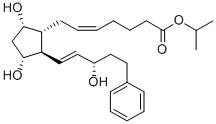

IdentificationPhysical DataSpectraRoute of Synthesis (ROS)Safety and HazardsOther Data
Identification
Product NameBimatoprost isopropyl esterIUPAC Namepropan-2-yl (Z)-7-cyclopentyl]hept-5-enoateMolecular StructureCAS Registry Number 130209-76-6MDL NumberMFCD00902150Synonyms130209-76-617-phenyl-trinor-PGF2alpha isopropyl esterdehydrolatanoprostBimatoprost isopropyl ester17-Phenyl trinor Pgf2alpha-Iprpropan-2-yl (Z)-7-cyclopentyl]hept-5-enoatePhDH 100A1IFH52MD8T17-Phenyl-18,19,20-trinor-pgf2alpha-1-isopropyl ester17-Phenyl trinor PGF2|A isopropyl ester5-Heptenoic acid, 7-cyclopentyl]-, 1-methylethyl ester, (5Z)-17-phenyl-trinor-Prostaglandin F2alpha isopropyl esterPhdh100Aisopropyl 9S,11R,15S-trihydroxy-17-phenyl-18,19,20-trinor-5Z,13E-prostadienoate130273-87-9UNII-1IFH52MD8T5-HEPTENOIC ACID, 7-((1R,2R,3R,5S)-3,5-DIHYDROXY-2-((1E,3S)-3-HYDROXY-5-PHENYL-1-PENTEN-1-YL)CYCLOPENTYL)-, 1-METHYLETHYL ESTER, (5Z)-PGF2Alpha,17-phenylSCHEMBL1954979CHEMBL2111623BDBM85339CHEBI:137717JGZRPRSJSQLFBO-FWPUOYPASA-NHMS3648J18BCP2902217-Phenyl-18,19,20-trinor-prostaglandin F2alpha-1-isopropyl ester17-PHENYLTRINORPGF2ALPHA-IPRLMFA03010124AKOS040756131HY-116161A(1R-(1alpha(Z),2beta(1E,3S),3alpha,5alpha))-1-Methylethyl 7-(3,5-dihydroxy-2-(3-hydroxy-5-phenyl-1-pentenyl)cyclopentyl)-5-heptenoate CAS_130209-76-6 CS-0128707 SR-01000946519 17-phenyl trinor Prostaglandin F2?? isopropyl ester SR-01000946519-1 Q27252458 17-PHENYL-18,19,20-TRINOR-PGF2.ALPHA.-1-ISOPROPYL ESTER ISOPROPYL PHENYLHYDROXYPENTENE DIHYDROXYCYCLOPENTYLHEPTENATE 17-phenyl trinor PGF2(c) paragraph sign-iPr;17-phenyl trinor PGF2(c) paragraph sign isopropyl ester 5-HEPTENOIC ACID, 7-((1R,2R,3R,5S)-3,5-DIHYDROXY-2-((1E,3S)-3-HYDROXY-5-PHENYL-1-PENTENYL)CYCLOPENTYL)-, 1-METHYLETHYL ESTER, (5Z)- 5-HEPTENOIC ACID, 7-(3,5-DIHYDROXY-2-(3-HYDROXY-5-PHENYL-1-PENTENYL)CYCLOPENTYL)-, 1-METHYLETHYL ESTER, (1R-(1.ALPHA.(Z),2.BETA.(1E,3S),3.ALPHA.,5.ALPHA.))-5-Heptenoic acid, 7-(3,5-dihydroxy-2-(3-hydroxy-5-phenyl-1-pentenyl)cyclopentyl)-, 1-methylethyl ester, (1R-(1alpha(Z),2beta(1E,3S*),3alpha,5alpha))-Isopropyl (Z)-7-((1R,2R,3R,5S)-3,5-dihydroxy-2-((3S,E)-3-hydroxy-5-phenyl-pent-1-enyl)-cyclopentyl)-hept-5-enoatePhDH 100A; 5-Heptenoic acid, 7-cyclopentyl]-, 1-methylethyl ester, (5Z)-; 5-Heptenoic acid, 7-cyclopentyl]-, 1-methylethylMolecular FormulaC26H38O5Molecular Weight430.6InChIInChI=1S/C26H38O5/c1-19(2)31-26(30)13-9-4-3-8-12-22-23(25(29)18-24(22)28)17-16-21(27)15-14-20-10-6-5-7-11-20/h3,5-8,10-11,16-17,19,21-25,27-29H,4,9,12-15,18H2,1-2H3/b8-3-,17-16+/t21-,22+,23+,24-,25+/m0/s1InChI KeyJGZRPRSJSQLFBO-FWPUOYPASA-N Isomeric SMILESCC(C)OC(=O)CCC/C=CC1(C(1/C=C/(CCC2=CC=CC=C2)O)O)O
Patent InformationPatent IDTitlePublication DateUS2016/106651COMPOSITIONS AND METHODS FOR TREATING HAIR LOSS USING NON-NATURALLY OCCURRING PROSTAGLANDINS2016WO2009/35565PROSTAGLANDIN ANALOGUES FOR IMPLANT DEVICES AND METHODS2009US2009/259058Process for the Preparation of Prostaglandin Analogues and Intermediates Thereof2009
Physical Data
AppearancePale yellow to colorless oily liquid or pale yellow to white waxy solid
Spectra
Description (NMR Spectroscopy)Nucleus (NMR Spectroscopy)Solvents (NMR Spectroscopy)Chemical shifts1HCDCl3Chemical shifts13CCDCl3
Route of Synthesis (ROS)
Route of Synthesis (ROS) of Bimatoprost isopropyl ester CAS 130209-76-6
ConditionsYieldIn methanol at 80℃; for 24 - 48h;Experimental ProcedureExample 4. Preparation of 17-phenyl trinor PGF2α isobutyl amide from ester A solution of 17-phenyl- 13,14-dihydro trinor PGF2α isopropyl ester (43.3 mg, 0.1 mmol.) and isobutylamine (1.0 mL, 10.1 mmol.) in MeOH (4.0 mL) is heated to 80 0C for 24-48 hours. The reaction is cooled to room temperature and concentrated in vacuo. The residue was purified by flash chromatography on silica gel, using CH2Cl2ZMeOH as eluent to afford 17-phenyl trinor PGF2α isobutyl amide (> 80% yield).80%
Safety and Hazards
Pictogram(s)SignalDangerGHS Hazard StatementsH302+H312+H332 (100%): Harmful if swallowed, in contact with skin or if inhaled H302 (100%): Harmful if swallowed H312 (100%): Harmful in contact with skin H332 (100%): Harmful if inhaled H360 (100%): May damage fertility or the unborn child Precautionary Statement CodesP203, P261, P264, P270, P271, P280, P301+P317, P302+P352, P304+P340, P317, P318, P321, P330, P362+P364, P405, and P501(The corresponding statement to each P-code can be found at the GHS Classification page.)
Other Data
HS CodeStorageStore -10°C for long time, in container tightly sealed; Protect from light and moisture.Shelf Life2 yearMarket Price
DruglikenessLipinski rules componentMolecular Weight430.585logP4.145HBA5HBD3Matching Lipinski Rules4Veber rules componentPolar Surface Area (PSA)86.99Rotatable Bond (RotB)13Matching Veber Rules1
Use PatternBimatoprost is widely used in the cosmetic field to promote eyelash growth. Its mechanism of action and effects are as follows:Mechanism of ActionBimatoprost prolongs the growth phase of eyelashes (the active phase in the eyelash growth cycle) and increases the number of hair follicles, stimulating natural eyelash growth. This mechanism significantly enhances eyelash density, length, and pigmentation.Application MethodIt is typically applied topically using a special applicator to place the solution at the base of the upper eyelashes (avoiding contact with the eyes and lower lashes). A common recommendation is to apply it once daily.EffectivenessBimatoprost use generally starts to show results after 4–8 weeks, with optimal effects observed at 12–16 weeks. Eyelashes become noticeably longer, denser, and darker due to increased pigmentation, giving them a more prominent and defined appearance. https://www.chemwhat.com/bimatoprost-isopropyl-ester-cas-130209-76-6/
Comments
Post a Comment